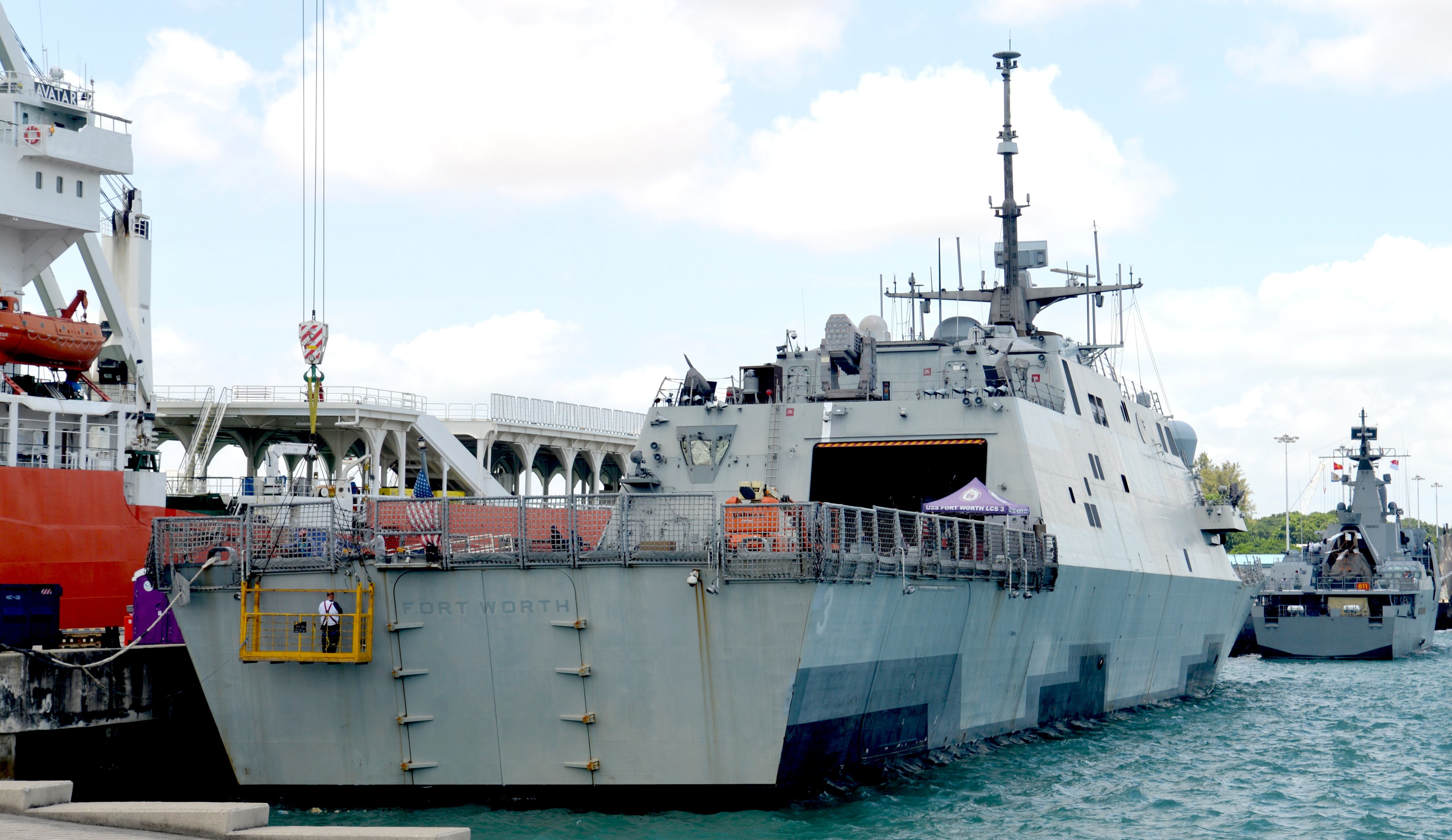The US Navy began the year 1945 with an assault in Lingayen Gulf on the Philippine island of Luzon. Japanese kamikazes rained on the invasion fleet, and two struck the heavy cruiser Louisville, one on Jan. 5 and another the following day. The Jan. 6 attack was the worst — the kamikaze hit the bridge structure and released his bomb just before impact to wreck the ship's No. 2 8-inch gun turret. The communications room, bridge and flag bridge were blasted. Forty-one sailors were killed and many more wounded.
The Navy ordered Louisville stateside for repairs, and a month later, on Feb. 5, it arrived at Mare Island Navy Yard on San Francisco Bay. Despite the extensive damage, the cruiser was ready to carry out sea trials April 7, repaired and upgraded with better radars and electronic gear. It was back in action in the western Pacific by May.
This past January, another US Navy ship was operating in the western Pacific. The littoral combat ship (LCS) Fort Worth was in the midst of a deployment that by all accounts was remarkably successful. It had the highest operational availability of any ship in the Navy, and the planned 16-month deployment had recently been extended. It was a singular success for the nascent and oft-criticized LCS program.

The Fort Worth at Singapore's Changi naval base on Feb. 16, more than a month after a major machinery accident. As of mid-May the ship is still at Changi awaiting repairs.
Photo Credit: Christopher P. Cavas/Staff
But that success came to a crashing halt Jan. 12 while the ship was undergoing regular maintenance pierside in Singapore. While results of the mishap investigation have yet to be made public, sources indicate someone ordered the ship's diesel engines to be turned on, overriding built-in safety features and manual instructions that specifically advised not to do so. The engines ran for more than 15 minutes, and when they were finally turned off the ship's combining gear — the interchanges that allow gas turbines or diesels to be cross-connected to propulsion shafts — was wrecked.
Seventh Fleet commander Vice Adm. Joseph Aucoin spoke with me a month later about Fort Worth's situation. The damage assessment was not then complete, but enough information was available to indicate that while the diesels couldn't be engaged, the ship was capable of using its gas turbines. Not an optimal situation for sure, but doable. At the time, Aucoin estimated the ship would need six to 12 months for machinery repairs. The question then was where to fix the LCS — either at a shipyard in Singapore, in Japan, or back in the US, where the Fort Worth already was set up for an overhaul in San Diego upon its return. Options for moving the ship included running only on the gas turbines — usually used just for high-speed operations — and the bad-for-publicity choices of being towed across the Pacific or making the journey high-and-dry aboard a heavy-lift ship.
"I'd like to get it fixed expeditiously," Aucoin said Feb. 15. He would not commit, however, to a time frame for a decision simply on where to repair the ship.
I visited the Fort Worth pierside at Singapore's Changi naval base Feb. 16. There was not a lot of activity onboard — crew members were carrying out regular maintenance, but as might be expected things were generally quiet. The steady pace of operations of the previous year had been replaced by a sense of ennui, waiting for word on what was next.
The plan to forward-base LCSs in Singapore has been in place for several years and remains a work in progress. The complex scheme to provide logistics, material support and repair facilities was tested during the first LCS deployment in 2013 and refined for the Fort Worth's cruise. A year ago, Navy officials were routinely speaking of having four LCSs operating from Singapore by 2017.
One must presume that contingency plans to repair LCSs that broke down or were damaged were considered, drawn up and approved long before the LCS Freedom began its 2013 deployment. Such plans would need to be approved by multiple stakeholders — among them US Pacific Fleet in Pearl Harbor; 7th Fleet in Yokosuka, Japan; Commander Surface Forces and LCS Squadron 1 in San Diego; Naval Sea Systems Command in Washington; not to mention Pacific Command in Pearl and the chief of naval operations in the Pentagon. Numerous lower-level activities and commands also should have had a hand in the planning.
No one claims the decisions were simple or easy — there is a lot to consider, from cost to politics to legal questions on top of all the hardware issues. But it's clear that when the Fort Worth was hurt Jan. 12 the Navy's decision-making apparatus was unprepared and unable to come to a quick and clear consensus. Only on April 13 did the service announce the ship would travel under its own power to San Diego. It's still at Changi as of mid-May, and apparently won't be leaving at least until late June. It'll likely be mid- or late-summer before it even arrives in California to begin repairs, and late 2017 or even 2018 before it's again ready for service.
That's just unacceptable. Whatever the reasons, today's Navy leadership needs to take a lesson from 1945 and get it in gear. Assess the situation, consider the alternatives and make a decision. Ineffective management has just delivered a real blow to the LCS program just as it was starting to roll.








